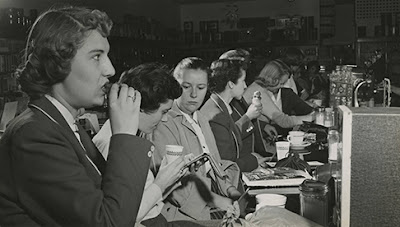Today, UNCG students can find small shops selling snacks and other sundries in various places across campus. But in the earlier years of the university, the on-campus shopping options were significantly fewer – and often run by the students themselves.
In 1913, the junior class decided to raise money to support their annual banquet and dance through sale of hot soup, hot chocolate, and sandwiches from a small basement kitchenette in the Curry Building. Both college students and students at the Curry School were able to purchase these lunches. Each item cost five cents. This was a time consuming job, however, and in the late 1910s, they shifted their focus to a small stand in the campus post office that sold pennants, hairnets, and other small items. The stand, which was dubbed Ye Junior Shoppe, also served as a site for coordinating the development of film.
 |
| Entrance to the Junior Shoppe, Administration Building (now Foust) |
Dormitory-based shops were the next evolution in student-led campus stores. One junior in each dormitory would serve as an in-residence sales person for high-demand items like hairpins. The stand in the campus post office continued as well. A poem in the January 22, 1921 issue of The Carolinian student newspaper advertised the shop:
Patronize “Ye Junior Shoppe” at all times,
Save up your nickles and your dimes,
To buy of its many wares and novelties,
You can get necessities and frivolities,
And too, it is so near at hand;
Right in the post office is the Junior Stand.
In the 1922-1923 school year, President Julius Foust allowed the junior class to open a formal store in a designated location on campus. The shop operated in some years in the Students’ Building; in others it had a space in the Administration Building (now Foust). They sold items including snacks, camera film, hair nets, picture postcards of campus, memory books, and college rings. In its first year of operation, the shop made a profit of $800.
Over the years, the inventory of the store grew.. In 1931, the shop installed tables and chairs and began selling sandwiches and cold drinks. By the mid-1940s, it was so successful that the store’s annual profit grew to nearly $12,000. In a 1990 oral history interview, Margaret Daniel Wilkerson Thurston (class of 1949) noted, “the room probably should have held twenty people, and there would be two hundred in there.” Chancellor Walter Clinton Jackson argued that this was more money than the junior class needed, so, in 1945, the college took over operations of the shop.
Renamed the Soda Shop, it moved in 1948 into a new building on College Avenue. This building was located on the former site of the Wooden Dormitory (also known as Little Guilford), which had just been demolished. Profits from the Soda Shop were used to finance student scholarships.
1949 also saw the demolition of the old Students’ Building and, soon after, the construction of the new Elliott Hall, which opened in 1953. In the early 1960s, Elliott Hall added a small cafeteria, which was also known as the Soda Shop. The next-door soda shop building was then transformed into a faculty center in 1963.
By Erin Lawrimore
